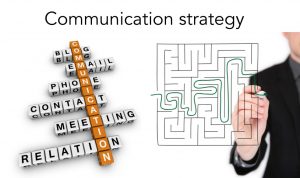
Working in public relations for almost nine years now, I always thought I understood marketing. Two of my college roommates were marketing majors, so we discussed similarities in our classes quite a bit. I worked hand-in-hand with marketing departments in previous positions. When I took my Accredited in Public Relations exam, I had to be able to answer questions on the differences between marketing and PR.
This past spring I took my first dedicated course in marketing for my master’s degree, Marketing Management. Our final project for the semester was to create a full marketing plan. In the words of Ygritte, I knew nothing.
PR vs. Marketing
From the APR Study Guide, marketing is defined as “the management function that identifies human needs and wants, offers products and services to satisfy those demands, and causes transactions that deliver products and services in exchange for something of value to the provider.” There is so much more to it.
Diving headfirst into this course, I learned just how involved in the overall business marketing is. The 4 Ps (Product, Placement, Pricing and Promotion) of marketing establish the foundation for the business model. What I thought meant having a seat at the table was so much more in depth than I realized. Not only does the marketing professional have a seat at the table, but he is also shaping how the business is actually run from what the company will make, how it will get the goods into the hands of the consumers, how much it will charge for the goods, and (stepping into the PR lane) how it will communicate the goods to those consumers.
As a PR professional, it might be heretical of me to say, but we can learn a lot about business management from our marketing brethren. Defined by the Public Relations Society of America as the “strategic communication process that builds mutually beneficial relationships between organizations and their publics,” PR focuses on the relationship function of business and can sometime miss other important factors that keep a company viable. Instead of placing the functions in silos, PR and marketing need to work together and learn from each other for the greatest good of the organization.
What is a marketing plan?
I’ve discussed many times on this blog the importance of strategic communications planning and how to create and implement your own plan. With the 10-step process, a strategic communications plan directs your promotional efforts to receive the best results possible. A marketing plan, though, takes in the three other Ps of the business model.
Defined by Charles W. Lamb, Joseph F. Hair Jr. and Carl McDaniel in their book MKTG (the textbook for my class), market planning is “designing activities relating to marketing objectives and the changing marketing environment” that culminates in the marketing plan, “a written document that acts as a guidebook of marketing activities for the marketing manager.” The following elements make up a complete marketing plan:
1) Mission Statement
The overarching reason the company exists forms the basis for any marketing plan, be that for the organization itself, a new product or service, or the initiation of a new program. This area of the marketing plan will also be used to outline what the organization is currently facing entering into the marketing plan, why it may need this new plan.
For the final class project, my team created a marketing plan for Shriners International to gain new members. With a steady decline in membership for the past several years, the fraternal organization is facing a threat to its existence.
2) Environmental Analysis
Similar to the research conducted in the strategic communications plan, an environmental analysis looks at the big picture. Using a Strength, Weakness, Opportunities and Threats structure, the analysis takes into account all the factors that are affecting an organization, good or bad, and what the organizations needs to do to remain relevant in the market.
As most civil and social clubs have faced today, a variety of societal, fiscal and technological factors has affected Shriners International’s membership. With more presence online and targeting once untapped populations, the fraternal order can rebound
3) Target Market
Segment. Segment. Segment. A detailed description with demographic information about who the marketing plan aims to inform, educate, make aware, and affect behavior. Along with the a detailed description, the reason why this audience is chosen is also stated with research about the consumer behavior and how the product or service needs to be positioned within the audience’s context for awareness, preference and selection.
To access a fresh market that hadn’t been tapped before by the Shriners, second-generation Latino males aged 30 to 39 in the Los Angeles metro were selected as the target audience.
4) Competitive Analysis
Part of a marketing plan is to understand yourself and your competition in relations to what the customer wants. Look at your and your competitors’ strengths and weaknesses, similarities and differences. By creating a customer competitor matrix or competitive profile matrix where you assign weight to an organization’s offerings based upon how important it is to the consumers and compare those offerings to at least your three top competitors, you can gain better insight into how to serve your target audience and rise above the competition. This is also the portion of the marketing plan where you calculate what percentage of market share you need to be a viable organization in the market.
The top competitors for membership to Shriners International were selected as the Knights of Columbus, Rotary International and local Chambers of Commerce. In Los Angeles, a market share of 23 percent was needed to sustain Shriners International.
5) Product Strategy
With the upfront research completed, the second phase of a marketing plan digs into the 4 Ps. Starting with the product or service itself, the product/service strategy is where the details are ironed out. You discuss where the product/service is in the product life cycle; where the product/service characteristics fall in the market, class, form, line and item categories; how the product/service is branded in the minds of the consumers; the quality of the product/service and risks to that quality; and finally you find the unique attribute about the product/service that gives it its competitive advantage over its competition.
In our marketing plan for the Shriners International, we developed a proof of concept idea to create ethnically-focused clubs to support temples worldwide. These clubs would provide a more familiar setting for members who sought a place of belonging over other membership opportunities.
6) Pricing Strategy
What price do you need to sell your product/service at to make a profit and be viable? Set your pricing objectives, be that to make a profit, establish a foothold in the market, or another directive, and then calculate the costs from there. You will need to identify how your target audience is going through the process to decide on your product/service (recognizing a problem, acquiring information, evaluating alternatives, making a choice, and how they interact with the brand after the purchase) and where you might be losing them in the sales funnel. Then a budget, including expenses, revenues, and variable and fixed costs, must be established along with your break-even analysis. With these calculations, you then should be able to set a reasonable price that covers your cost and brings in a profit.
To form an ethnic-focused club in the Los Angeles metro, our marketing plan determined that at least 30 members paying a $45 monthly membership fee would be needed to establish a viable organization.
6) Distribution Strategy
The distribution strategy of a marketing plan establishes what channels you will use to deliver your product/service into the hands of the customer. Reviewing the physical system of order processing, customer service and transportation, your plan will have to detail how you will be able to meet the demand created for the product/service.
For the newly-established Hispanic-focused club, a direct distribution method through direct sales and marketing was needed. By assigning founding members to new recruits in an area close to where the target audience lived and worked, the new club could deliver services quickly and conveniently.
7) Promotional Strategy
The objectives, strategies, tactics, timeline and budget of a strategic communications plan compose the promotional strategy of a marketing plan. These items are used to devise a plan to communicate the product/service to the target audience.
With the aim of increasing membership among Latino males, strategies and tactics involving social media and special holiday events were planned in the Shriners International marketing plan.
8) Evaluation
The final section of the marketing plan is your evaluation measures. How will you determine your efforts have moved the needle in sales, donations, awareness or whatever else the objectives of your plan are? Much of the information you review in this stage will also help you prepare your Customer Relationship Management program.
Along with social media analytics and new signups, our marketing plan also included a system for establishing community outreach efforts to potential recruits who voluntarily provided contact information.
How will you develop your marketing plan?
A marketing plan is an essential part of business, but there are some major difference between it and a strategic communications plan. Both are important in developing your business and offer their own advantages. Use both to establish and communicate your offerings to your customers.
What are you doing now to market your product/service? How can a marketing plan help you to do it better?



